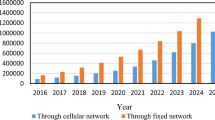Abstract
In this paper, performance of an improved resource allocation scheme with half-duplex and full-duplex relaying strategies in a cooperative cognitive radio network is studied. An improved resource allocation scheme in this work refers to an improved joint channel allocation and relay assignment (JCARA) scheme. The problem of maximizing the spectrum efficiency among multiple cognitive radio (CR) source–destination pairs, under both relaying strategies is studied with the number of channels, CR source- destination pairs, and CR relays. An improved channel allocation and relay assignment is carried out in the proposed algorithm to further increase spectrum efficiency. It is also shown that an improved JCARA results in better performance in terms of maximized minimum transmission rate than the results which are obtained through existing algorithm given in the literature. It is also demonstrated that the full-duplex relaying strategy which is first studied in this resource allocation scheme, results in an increased spectrum efficiency than the half-duplex relaying and CR relays are better utilized in full-duplex relaying. Numerical results are presented to show the effectiveness of an improved JCARA with full-duplex relaying and with half-duplex relaying.








Similar content being viewed by others
References
Haykin, S. (2005). Cognitive radio: Brain-empowered wireless communications. IEEE Journal on Selected Areas in Communications, 23(2), 201–220.
Thomas, T., & Gamal, A. E. (1979). Capacity theorems for the relay channel. IEEE Transactions on Information Theory, 25(5), 572–584.
Van Der Meulen, E. C. (1971). Three-terminal communication channels. Advances in Applied Probability, 3, 120–154.
Laneman, J. N., Tse, D. N. C., & Wornell, G. W. (2004). Cooperative diversity in wireless networks: Efficient protocols and outage behavior. IEEE Transactions on Information Theory, 50(12), 3062–3080.
Azarian, K., El Gamal, H., & Schniter, P. (2005). On the achievable diversity-multiplexing tradeoff in half-duplex cooperative channels. IEEE Transactions on information theory, 51(12), 4152–4172.
Ding, Z., Leung, K. K., Goeckel, D. L., & Towsley, D. (2009). On the study of network coding with diversity. IEEE Transactions on Wireless Communications, 8(3), 1247–1259.
Riihonen, T., Werner, S., & Wichman, R. (2009). Optimized gain control for single-frequency relaying with loop interference. IEEE Transactions on Wireless Communications, 8(6), 2801–2806.
Riihonen, T., Werner, S., & Wichman, R. (2011). Hybrid full-duplex/half-duplex relaying with transmit power adaptation. IEEE Transactions on Wireless Communications, 10(9), 3074–3085.
Song, L., Li, Y., & Han, Z. (2015). Resource allocation in full-duplex communications for future wireless networks. IEEE Wireless Communications, 22(4), 88–96.
Liu, Gang, Yu, F Richard, Ji, Hong & Leung, Victor CM. (2014). Energy-efficient resource allocation in shared full-duplex relaying cellular networks. In Global communications conference (GLOBECOM), 2014 IEEE, pp. 2631–2636.
Krikidis, I., Suraweera, H. A., Smith, P. J., & Yuen, C. (2012). Full-duplex relay selection for amplify-and-forward cooperative networks. IEEE Transactions on Wireless Communications, 11(12), 4381–4393.
Zhang, Z., Chai, X., Long, K., Vasilakos, V., & Hanzo, L. (2015). Full duplex techniques for 5G networks: self-interference cancellation, protocol design, and relay selection. IEEE Communications Magazine, 53(5), 128–137.
Chen, G., Xiao, P., Kelly, J., Li, B., & Tafazolli, R. (2017). Full-duplex wireless-powered relay in two way cooperative networks. IEEE Access, 5, 1548–1558.
Riihonen, T., Werner, S., & Wichman, R. (2011). Mitigation of loopback self-interference in full-duplex mimo relays. IEEE Transactions on Signal Processing, 59(12), 5983–5993.
Mohammadi, M., Chalise, B. K., Suraweera, H. A., Zhong, C., Zheng, G., & Krikidis, I. (2016). Throughput analysis and optimization of wireless-powered multiple antenna full-duplex relay systems. IEEE Transactions on Communications, 64(4), 1769–1785.
Bletsas, A., Khisti, A., Reed, D. P., & Lippman, A. (2006). A simple cooperative diversity method based on network path selection. IEEE Journal on Selected Areas in Communications, 24(3), 659–672.
Zhao, Y. I., Adve, R., & Lim, T. (2007). Improving amplify-and-forward relay networks: Optimal power allocation versus selection. IEEE Transactions on Wireless communications, 6(8), 3114–3123.
Sharma, S., Shi, Y., Hou, Y. T., & Kompella, S. (2011). An optimal algorithm for relay node assignment in cooperative ad hoc networks. IEEE/ACM Transactions on Networking (TON), 19(3), 879–892.
Yang, D., Fang, X., & Xue, G. (2012). HERA: An optimal relay assignment scheme for cooperative networks. IEEE Journal on Selected Areas in Communications, 30(2), 245–253.
Li, P., Guo, S., & Cheng, Z. (2014). Max-min lifetime optimization for cooperative communications in multi-channel wireless networks. IEEE Transactions on Parallel and Distributed Systems, 25(6), 1533–1542.
Li, P., Guo, S., Zhuang, W., & Ye, B. (2014). On efficient resource allocation for cognitive and cooperative communications. IEEE Journal on Selected Areas in Communications, 32(2), 264–273.
Mishra, S., & Trivedi, A. (2014). Relay selection with channel allocation for cognitive radio relay channels in crn. In Eleventh International Conference on Wireless and Optical Communications Networks (WOCN), pp. 1–4.
Boyd, S., & Vandenberghe, L. (2004). Convex optimization. Cambridge: Cambridge University Press.
Author information
Authors and Affiliations
Corresponding author
Rights and permissions
About this article
Cite this article
Mishra, S., Trivedi, A. Performance Study of an Improved Resource Allocation Scheme with Full-Duplex Relaying. Wireless Pers Commun 98, 2819–2836 (2018). https://doi.org/10.1007/s11277-017-5002-9
Published:
Issue Date:
DOI: https://doi.org/10.1007/s11277-017-5002-9




